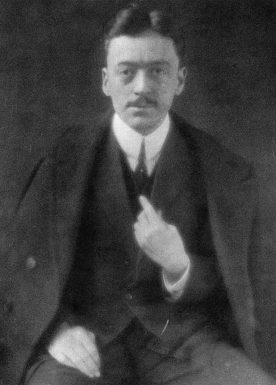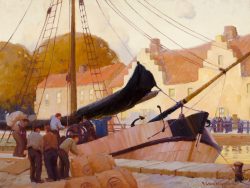Unknown photographer, Portrait of Victor Higgins, n.d. gelatin silver print. New Mexico Museum of Art Library and Archives, Victor Higgins Papers. Gift of the Joan Higgins Reed Estate, 1984.

Victor Higgins 1884–1949
Raised in rural Shelbyville, Indiana, William Victor Higgins left his family’s farm for Chicago at age fifteen determined to become an artist. While studying at the Chicago Academy of Fine Arts (founded in 1902) and at the Art Institute of Chicago, he worked as a sign painter and scenic decorator, eventually partnering with Harry L. Engle, a fellow member of the Palette and Chisel Club. In 1910, Higgins painted in Southern California; the following year he went to New York and then to Europe. During his more than two years abroad, Higgins traveled widely, working in England, Germany, Belgium, France, and Italy. As a student in Munich he became a charter member of the American Artists’ Club along with E. Martin Hennings and Walter Ufer; all three later became members of the Taos Society of Artists, in New Mexico.
On Higgins’s return to Chicago in 1913, thirty-five of his paintings were shown in a solo exhibition at the Palette and Chisel. At the club’s annual exhibition of 1914 he won its gold medal. That year, he made his first visit to New Mexico with the encouragement of Chicago mayor Carter H. Harrison, who also invited Higgins to represent the club on the newly formed Commission for the Encouragement of Local Art. For the next several years, a syndicate of midwestern businessmen headed by Carter financed Higgins’s work in Taos, site of a burgeoning artists’ colony. While painting the landscape and people of New Mexico, Higgins also remained prominent in the Chicago art world, winning eight prizes between 1915 and 1918. Exhibiting nationally, he maintained a Chicago address until 1921, when he became a full-time resident of Taos. That year, he was elected an associate member of the National Academy of Design; full membership followed in 1935. In 1918, Higgins married Sara Parsons, daughter of painter and Taos resident Sheldon Parsons; the couple divorced in 1924.
In the early 1920s, Higgins began experimenting with imagery drawn from myth and fantasy; in his pure landscapes and still lifes, he played with abstraction in his reductive, stylized representation of the forms of mountains, adobe houses, and flowers. Higgins’s engagement with modernism was partly stimulated by his association in Taos with such artists as Andrew Dasburg and John Marin. Even before meeting Marin, a master of watercolor painting, Higgins began using that medium to explore abstraction. With other members of the Taos Society of Artists he also worked on mural projects, notably in the Missouri State Capitol building. Notwithstanding his critical success, the artist’s finances were never secure, a situation he briefly remedied with marriage in the late 1930s to San Antonio, Texas, heiress Marion Koogler McNay. Otherwise, Higgins remained a resident of Taos, painting there until just before his death at age sixty-five.
Wendy Greenhouse, PhD
